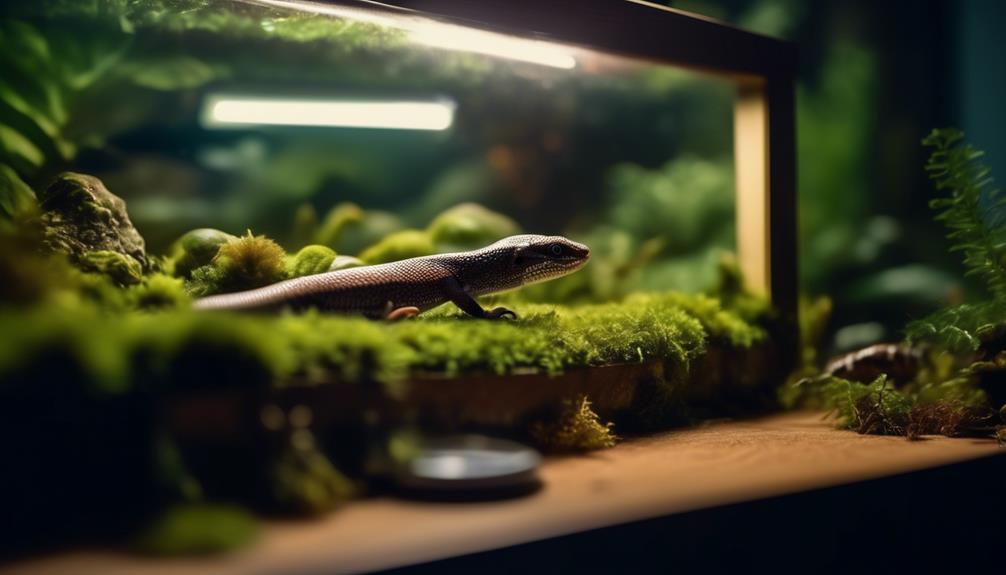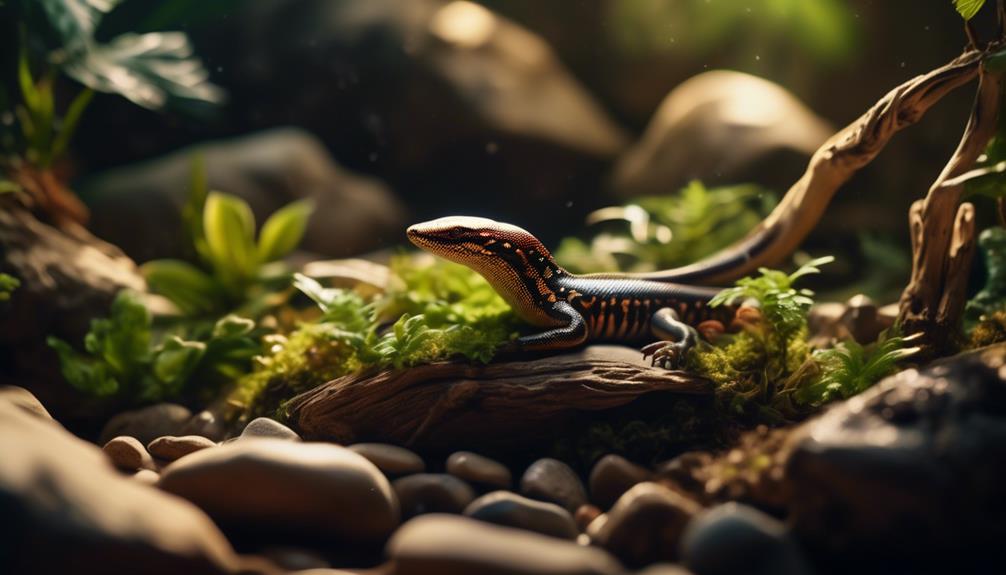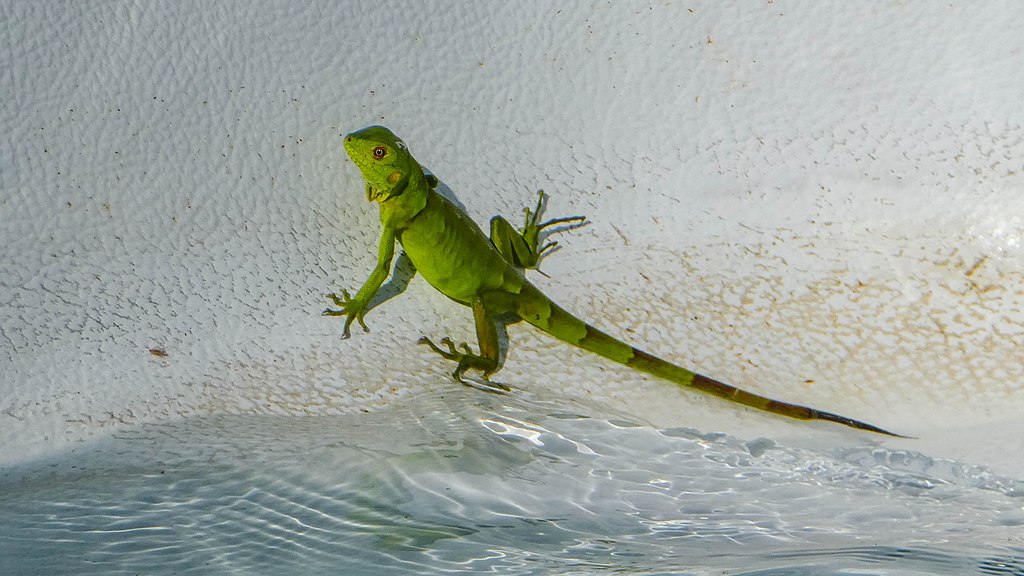Are you ready to embark on a captivating journey into the hidden world of Schneider's skinks? Prepare to be amazed as we unveil the enigmatic secrets to their thriving existence.
These remarkable creatures hold the key to a world of wonder, and in this discussion, we will reveal the essential knowledge and insights that will leave you craving for more.
So, join us as we venture into the depths of Schneider's skinks' secrets, and discover the extraordinary measures required to ensure their health, happiness, and longevity.
Key Takeaways
- Schneider's skinks require an appropriately sized enclosure, with a minimum size of 36L x 18W x 16H for smaller skinks and 48L x 24W x 24H for larger skinks.
- High-quality UVB lighting is essential for their health, and recommended bulbs depend on the height of the enclosure.
- Temperature and humidity should be carefully regulated, with a basking surface temperature of 105-115°F and a cooler area of 75-85°F. Humidity should be kept under 50% on average.
- The skinks' diet primarily consists of insects, with juveniles requiring daily feeding and adults fed 2-3 times per week. Calcium and vitamin supplements should be provided, and a clean water bowl should always be available.
Enclosure Requirements for Schneider's Skinks

When providing an enclosure for Schneider's skinks, it's important to adhere to specific requirements to ensure their optimal health and well-being. The size of the enclosure plays a crucial role in their overall comfort and activity levels. For skinks under 14 inches, the minimum enclosure size should be 36 inches in length, 18 inches in width, and 16 inches in height. Larger skinks require a minimum enclosure size of 48 inches in length, 24 inches in width, and 24 inches in height. However, it's always better to provide larger enclosures whenever possible.
In terms of lighting, high-quality UVB lighting is essential for their health. Since Schneider's skinks are diurnal and most active during the day, it's recommended to use UVB bulbs suitable for their enclosure height. For 16-18 inch tall enclosures, the recommended UVB bulb options are the Arcadia T5 HO Forest 6% and the Zoo Med T5 HO Reptisun 5.0. For 24-inch tall enclosures, it's recommended to use the Arcadia T5 HO Desert 12% or the Zoo Med T5 HO Reptisun 10.0. The UVB bulb should be roughly half the length of the enclosure and housed in an Arcadia or Vivarium Electronics fixture with a reflector.
UVB Lighting for Optimal Health
To ensure the optimal health of Schneider's skinks, providing appropriate UVB lighting is crucial for their well-being. UVB lighting plays a vital role in their overall health and helps to prevent potential health issues. Here are three important points to consider when it comes to UVB lighting for Schneider's skinks:
- UVB Bulb Options: It's recommended to use high-quality UVB bulbs specifically designed for reptiles. For enclosures that are 16-18 inches tall, options such as the Arcadia T5 HO Forest 6% or the Zoo Med T5 HO Reptisun 5.0 are recommended. For taller enclosures of 24 inches, the Arcadia T5 HO Desert 12% or the Zoo Med T5 HO Reptisun 10.0 are suitable choices.
- Importance of UVB Lighting: Schneider's skinks are diurnal creatures, meaning they're most active during the day. UVB lighting helps them metabolize calcium properly, which is essential for maintaining healthy bones and preventing metabolic bone disease.
- Proper Setup: The UVB bulb should be roughly half the length of the enclosure and housed in an Arcadia or Vivarium Electronics fixture with a reflector. This setup ensures that the skinks receive adequate UVB exposure throughout the enclosure.
Temperature and Humidity Guidelines

Maintaining appropriate temperature and humidity levels is crucial for the well-being of Schneider's skinks in order to create an environment that mimics their natural habitat. Skinks are ectothermic animals, meaning they rely on external sources of heat to regulate their body temperature. Temperature and humidity management is essential to ensure their physiological processes function optimally.
To help skinks thrive, it is important to provide a temperature gradient within their enclosure. This can be achieved by using heat sources such as low-wattage halogen heat lamps. The basking surface temperature should range from 105-115°F, while the cooler area on the opposite side should be maintained at 75-85°F. It is crucial to turn off heat sources at night to allow for a drop in temperature.
In terms of humidity, skinks prefer a low average humidity level of under 50%. This can be measured using a digital probe hygrometer. To help maintain humidity levels, the enclosure can be misted weekly using a pressure sprayer.
In summary, temperature and humidity management is vital for the well-being of Schneider's skinks. Providing a proper temperature gradient and maintaining appropriate humidity levels will help ensure their physiological needs are met, allowing them to thrive in captivity.
| Temperature Guidelines | Humidity Guidelines | Handling and Bonding Techniques |
|---|---|---|
| Basking surface temperature: 105-115°F | Low average humidity under 50% | Few reptiles enjoy being held, but skinks can become accustomed to handling |
| Cooler area temperature: 75-85°F | Use a digital probe hygrometer to measure humidity levels | Develop a bond by offering food with soft-tipped feeding tongs |
| Heat sources should be turned off at night | Enclosure can be misted weekly with a pressure sprayer | Avoid grabbing the skink, instead scoop from below or encourage them to come to you |
| Use low-wattage halogen heat lamps | Patient effort is required for successful handling |
Substrate and Decor Tips for a Natural Habitat
For creating a natural habitat for Schneider's skinks, it's essential to carefully select appropriate substrate and provide various types of decor. Here are three important tips to consider:
- Substrate: Use sand or sandy soil as the substrate for your skink's enclosure. Recommended substrates include Zoo Med ReptiSand and Exo Terra Desert Sand. The substrate should be at least 4 inches deep and replaced every 3-4 months. It imitates the reptile's natural habitat and provides something for them to dig in.
- Decor: Provide a variety of decor to create an enriching habitat. Sturdy logs and branches, stacks of flat rocks, and ledges for climbing are all great options. Additional hides should be provided for security.
- Plants: You can also consider adding drought-tolerant live or artificial plants to add a touch of nature to the enclosure. They can provide visual interest and create hiding spots for the skinks.
Remember to research the specific needs and preferences of Schneider's skinks to ensure you are providing the best possible habitat for them.
Proper Diet, Supplements, and Water Care

Proper nutrition and supplementation are crucial for the overall health and well-being of Schneider's skinks. These insectivorous reptiles require a varied diet to meet their nutritional needs. Juveniles should be fed daily, while adults can be fed 2-3 times per week. Feeder insects such as dubias, crickets, and mealworms should be offered in abundance during a 5-minute feeding period. To prevent deficiencies, it is important to use calcium and vitamin supplements. We recommend Repashy Calcium Plus LoD as a reliable supplement option. Additionally, Schneider's skinks should always have access to clean water. Provide a medium water bowl and change the water daily, while also scrubbing the bowl with reptile-safe disinfectant weekly.
| Diet | Supplements | Water Care |
|---|---|---|
| Offer varied insects | Use calcium and vitamin supplements | Provide clean water bowl |
| Feed daily for juveniles, 2-3 times per week for adults | Recommended: Repashy Calcium Plus LoD | Change water daily |
| Offer as much as they can eat in 5 minutes | Prevent deficiencies | Scrub bowl with reptile-safe disinfectant weekly |
| Include occasional chopped fruit treats |
Proper handling techniques are also important for the well-being of Schneider's skinks. While few reptiles enjoy being held, skinks can become accustomed to handling with patient effort. To develop a bond, offer food with soft-tipped feeding tongs and avoid grabbing the skink. Instead, scoop from below or encourage them to come to you. Remember, further research is recommended to ensure comprehensive care for these fascinating reptiles.
Frequently Asked Questions
Can Schneider's Skinks Be Housed Together in the Same Enclosure?
Yes, Schneider's skinks can be housed together in the same enclosure for breeding purposes, but it is not required for their overall wellbeing. It is important to monitor their social behavior and provide adequate space for each skink.
What Is the Recommended Size for the Enclosure of Skinks Under 14 Inches Long?
The recommended enclosure size for skinks under 14 inches long is 36L x 18W x 16H. This provides enough space for them to move and explore. Larger enclosures are always better for their overall well-being.
How Often Should the Substrate Be Replaced in the Skink's Enclosure?
We recommend replacing the substrate in the skink's enclosure every 3-4 months. Sand or sandy soil substrates, such as Zoo Med ReptiSand or Exo Terra Desert Sand, provide a natural habitat and something for the skink to dig in.
Are Schneider's Skinks Primarily Insectivorous?
Schneider's skinks are primarily insectivorous, with a diet consisting mainly of feeder insects such as dubias, crickets, and mealworms. Understanding their natural habitat and behavior is crucial for providing proper nutrition and meeting their dietary preferences.
How Should Schneider's Skinks Be Handled to Develop a Bond With Them?
To develop trust and build a bond with Schneider's skinks, we recommend offering food with soft-tipped feeding tongs, avoiding grabbing them, and instead scooping from below or encouraging them to come to you. Patience and effort are required for successful handling.
Conclusion
In conclusion, our comprehensive guide has uncovered the extraordinary secrets to ensuring the thriving existence of Schneider's skinks.
By following our expert advice on enclosure requirements, UVB lighting, temperature and humidity control, substrate and decor choices, and proper diet and supplements, you'll be equipped to provide the best possible care for these fascinating creatures.
Get ready to embark on an incredible journey of reptile care like never before, and witness the remarkable transformation of your Schneider's skinks into thriving, healthy, and happy companions.

